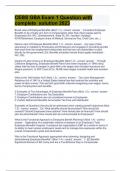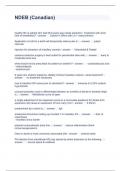Exam (elaborations)
ECS3707 Assignment 3 Semester 2 2024 | Due 17 September 2024
- Course
- Institution
- Book
ECS3707 Assignment 3 Semester 2 2024 | Due 17 September 2024. All questions answered. Question 1 1. Critically assess the merits of using economic metrics such as Gross Domestic Product (GDP) per capita versus broader multidimensional measures like the Human Development Index (HDI) or Mul...
[Show more]












